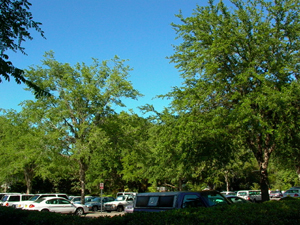Home > Site analysis > Diversity of species
Diversity of species
 Imagine the results if a major tree disease struck your neighborhood. |
 Here, a mixture of Ulmus alata and Quercus virginiana is used without any detriment to the design scheme. In fact, the landscape still maintains a uniform appearance. |
It has been a part of urban forestry teaching for so long that it seems redundant to state that communities and others should plant a variety of species. Most professionals do not recommend arbitrary selection of several species on the same site or along the same street for diversity sake. This usually looks poor.
One street or a portion of a commercial landscape often looks best when planted with one species, especially if trees will be placed in a row. This ties the design together. What many people suggest is a mix of species in the community.
Perhaps it began in the 1800's in this country with planting of American elm, certainly one of the most elegant street and shade trees to grace our cities. So many were planted that when disease came, disaster struck.
Many communities now have only fragments of the original plantings due to devastation from Dutch elm disease. Those with significant numbers of American elm along their streets, such as Washington, D.C., spend considerable sums of money on regular monitoring and treatment programs.
The London plane and sycamore trees were very popular and over planted in many communities until the last decade or two when large numbers began dying from disease in certain communities. Austrian pine can be seen planted almost exclusively in many midwestern landscapes. They too grew fine until a tip blight disease began killing them in some regions.
In the 1960's, honeylocust began to emerge as the perennial favorite street tree in many communities in the northern U.S. There are now several problems beginning to catch up with this tree. Japanese black pine dominated the New Jersey and Long Island shore lines in the 1970's and 80's until an insect began its devastating march. Bradford callery pear has been considered a standard tree in the 70's and 80's in many areas of the country until it was determined that the structure was weak and they break apart.
The stories are all similar. Only the tree species and the insect, disease or other causal agent changes. If we listen, these experiences teach lessons. Plant a variety of trees in the community. This might require more work and creativity on your part. Talk to nursery operators and teachers, and use this web site to better inform yourself about tree selection.
Do not rely on the "magic pill" tree- though it might be easier in the short term to rely on the same 5 types of trees that have been used for years in your community. Reach out, touch, and plant some new trees for a more lasting urban forestry program.
It is impossible to predict where the next major devastating insect or disease will strike. I can think of one state, Florida, that has almost exclusively planted live oaks along streets, in parking lots, in commercial landscapes and in every other imaginable place. There are cities in the southeastern U.S. that are overplanted with willow oaks. Red oak is currently one of the most popular trees in the northern United States, and bald cypress is finally being recognized as a tree well adapted to many urban and suburban landscape sites. Will these too be overplanted?
When fatal diseases strike a community dominated by one tree species, the results to the landscape are shocking. Just imagine your neighborhood without any trees. The reasons for this happening are complex, but changes must be made if we are to develop an urban forest that can be sustained.

